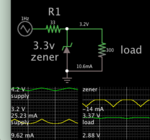J
Javid.zare.s
Guest

Hi fellas, I have a thing that I should improve any circuit that I design, back adays I've added lithium ion to my wireless mouse and its working fine
but the thing is the mouse circuit is designed for 3 volt s when the battery at full state is around 4.2 volts
for solving and reducing this voltage difference I added a diode to decrease voltage
As you know its not efficient and when my battery is at lower voltage the mouse stops working but I know there's still enough juice. (battery at 3.3v)
so is there a non-complex way ( considering 1cm*2cm*3cm space available in wireless mouse housing ) to have steady 3 volts at output of lithium battery?
- also efficiency matters
thanks in advance!
but the thing is the mouse circuit is designed for 3 volt s when the battery at full state is around 4.2 volts
for solving and reducing this voltage difference I added a diode to decrease voltage
As you know its not efficient and when my battery is at lower voltage the mouse stops working but I know there's still enough juice. (battery at 3.3v)
so is there a non-complex way ( considering 1cm*2cm*3cm space available in wireless mouse housing ) to have steady 3 volts at output of lithium battery?
- also efficiency matters
thanks in advance!
Last edited:



